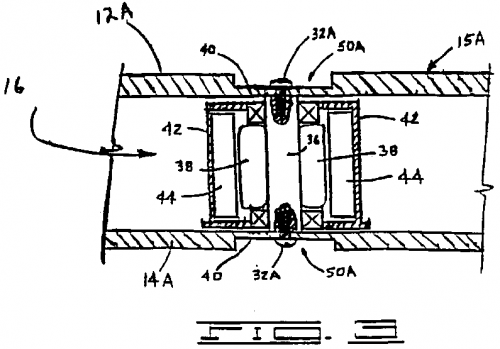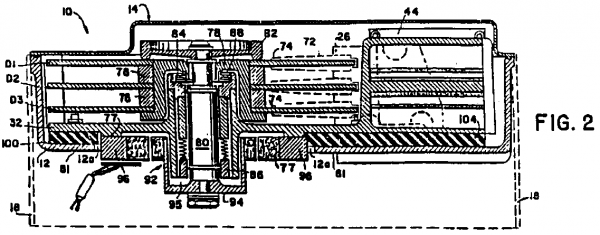2019年6月17日
著者:小野 康英(米国特許弁護士)

Madison Building, USPTO Alexandria Campus (Alexandria, VA) (著者撮影)
前回、米国特許商標庁(USPTO: United States Patent and Trademark Office)の手続におけるクレーム解釈のルールを紹介した。
今回は、最広義の合理的解釈(BRI: broadest reasonable interpretation)(BRI基準)の理解に好適と思われるMorris事件を紹介する。
In re Morris, 127 F.3d 1048 (Fed. Cir. 1997)
1.事件の経緯
(1)出願発明及び先行技術
Morris出願は、ディスク・ドライブ用音響アイソレータに関する。Morris出願の図3(ディスク・ドライブの部分的に詳細に描く断面図)によれば、本ディスク・ドライブは、上面筐体カバー(top housing cover)12A及び下面筐体カバー(bottom housing cover)14Aを含む。両カバーには、モーター16がネジ32Aにより固定されている。上面及び下面カバーの一部(portion of the top and bottom covers)50Aは、ネジ32Aから半径方向に延伸する領域が薄く削られている。明細書によれば、出願発明は、この「コンプライアンス・エリア(compliance area)」は、残りの筐体と比較して厚みが少ないことに起因して、音響ノイズ削減の効果を奏する。

一方、Brown特許(Pre-AIA 102(b)先行技術)の図2は、パッド100及びそれを取り囲む筐体12の断面図(a cross-section of the pad 100 and surrounding housing 12)を示す。同図によれば、パッド100は筐体12に固着している(a compliance area fixedly attached to a support member)。

(2)USPTOにおける手続
出願人は、複数回のクレーム拒絶後、Brown特許に基づく直近の拒絶OAに応答すべく、Claim 1に三度目の補正を行った。以下のクレームにおいて、[ ]で囲まれた部分は補正で削除された部分を示し、下線が付された部分は補正で追加された部分を示す。
1. (Thrice Amended) An improved acoustic isolation apparatus for reducing the acoustic noise produced by a system having at least one excitation source attached at a contact point to a sup-port member, the acoustic isolation apparatus comprising:
at least one acoustic compliance area integrally formed [on] as a portion of a selected area of the support member so as to impede selected frequencies of acoustic noise resulting from the coupling of the vibrations of the excitation source to the support member, the acoustic compliance area formed [on] as a portion of the support member such that [increased compliance is provided to] the support member has increased compliance substantially surrounding and extending radially about the contact point.
出願人は、Brown特許は「筐体『の一部として一体的に形成された』音響アイソレータ装置を教示も示唆もしない(does not teach or suggest an acoustic isolator apparatus which is ‘integrally formed as a portion of’ the housing)」と主張した。また出願人は、Brown特許はスペース及び部品点数を削減するという出願発明の主目的を達成できないと主張した。さらに出願人は、出願発明の音響コンプライアンス・エリア(acoustic compliance area)は「支持部材の一部として一体的に形成された(integrally formed as a portion of the support member)」ものであるため、Brown特許に付随する問題を生じさせることなく、音響ノイズの低減という目的を達成できると主張した。
審査官は、出願人の主張は拒絶を解消するのに十分でないとして、クレーム中の「(選択領域、筐体、又は支持部材)の一部として一体的に形成された(integrally formed as a portion of)」はBrown特許の音響コンプライアンス・エリア100を含むとして、最後の拒絶([final] rejection)を発行した。出願人はこれを不服として、審判請求を行った。
審判において、出願人は、明細書の記載に照らして、claim 1の"acoustic compliance area integrally formed as a portion of a selected area of the support member"を、「筐体において薄く削られた部分(thinned-down portion of a housing)」と解釈すべきと主張した。これに対し、USPTO審判部(BPAI: Board of Patent Appeals and Interferences)(注1)は、複数の判例を引用した上で、"integral"の語は、複数の部品を単一のユニットとして固定された状態で維持する(maintaining parts in a fixed relationship as a single unit)との意味が含まれ、また、出願人による解釈は、問題のクレームに明細書の限定を不当に読み込んでいると指摘した。BPAIは、結論として、審査官がBrown特許に基づきclaim 1を拒絶したことは正しいと結論した。出願人はこれを不服として、事件を連邦巡回区控訴裁へ控訴した。
(注1)リーヒ・スミス米国発明法(AIA: The Leahy–Smith America Invents Act (Public Law 112-29))により、Board of Patent Appeals and Interferences (BPAI)はPatent Trial and Appeal Board (PTAB)に承継された。See 35 U.S.C. 6.
2.連邦巡回区控訴裁判決
(1)結論
拒絶維持審決を維持。
(2)法廷意見の概要(起草者:Plager判事)
本事件の論点は、紛争に係るクレーム中の用語(disputed claim language)についてのUSPTOの解釈が合理的かどうかである。
出願人は、"integrally formed as a portion of"は、コンプライアンス・エリアが筐体と「互いに融合して(fused together)」、「単一の部材を構成する(to form a single part)」ことを要すると主張する。この点、審決の解釈は、BPAIが参酌した証拠に照らして合理的である。連邦巡回区控訴裁及び関税特許控訴裁(連邦巡回区控訴裁の前身裁判所)は、複数の事件において、"integral"の語は、単一の構造(unitary construction)以外の構造を含むと解釈した(注2)。出願人は、本事件をこれらの事件と区別しようとしているが、それは的外れである。明細書に明示の定義がない状況において、出願人が一の証拠に基づき自己に有利な定義を主張した場合でも、USPTOが自己の解釈を正当化する他の適切な証拠を提示したときには、そのUSPTOの解釈は合理的である。
(注2)See, e.g., In re Kohno, 391 F.2d 959 (CCPA 1968), In re Dike, 394 F.2d 584 (CCPA 1968), In re Larson, 340 F.2d 965, 144 USPQ 347 (CCPA 1965), In re Clark, 214 F.2d 148 (CCPA 1954), and Advanced Cardiovascular Sys. v. Scimed Life Sys., 887 F.2d 1070, 1074 (Fed.Cir.1989) that endorsed the interpretation by the CCPA.
また、出願人は、claim 1は、"compliance area"が、単に「"support member"と一体形成される(integrally formed from the support member)」と規定するのではなく、「"support member"の一部分として一体形成される("integrally formed as a portion of " the support member)」と規定すると主張する。しかし、この点は結論には影響を及ぼさない。Webster's Third New International Dictionary 1768 (1986)によれば、"portion"は、「何らかの物の一部又は部分(part or share of something)」と定義される。これによれば、"portion"は、"compliance area"が"support member"から分離可能かどうかについて何らの示唆も与えない。たとえば、パイのスライス(slice of pie)は、分離可能であるが、パイの一部(‘portion of’ the pie)とみなし得る。
さらに、出願人は、本願明細書及びBrownを含む先行技術を検討し、これらに照らして紛争に係るクレーム中の用語をより狭く解釈すべきと主張する。このような、出願人の解釈を出願及び先行技術と調和させる試みは、立証責任の分担を誤っている。発明を正確に定義する義務を負うのは出願人である。本事件における問題は、出願人が、自己の意図する解釈を明確にする努力を怠ったことにある。出願人は、クレームを明細書の記載に照らして解釈すべきと主張するが、"integrally formed"の語は、"Summary of the Invention"の項及び"advantages of the present invention"の項に登場するものの、これらの記載は、図面を参照していないし、明示の定義を与えていない。
出願人が紛争に係るクレーム中の用語を明細書で正確に定義せず、かつ、合理的な代替の定義(reasonable alternative definition)が存在する場合、USPTOはClaim 1を拒絶することが許されるだけでなく、拒絶しなければならない。
3.考察
(1)BRI基準に基づく主張
出願人は、クレームの"integrally formed"の解釈について、明細書及び先行技術に照らして、自己の主張する解釈の正当性を主張した。この点、本事件は、このアプローチがBRI基準においては有効でないことを教訓として残したと考えられる。本事件の法廷意見は、出願人が一の証拠に基づき自己に有利な定義を主張した場合でも、USPTOが自己の解釈を正当化する他の適切な証拠を提示したときには、そのUSPTOの解釈は合理的とされると判示した。これを前提とすると、BRI基準に基づくUSPTOの解釈を覆すためには、USPTOの解釈が不合理であることの根拠の探求により焦点を当てることが有効と考えられる。本事件の場合、Morris出願の明細書は、"integrally formed"の語を、クレーム以外では、"Summary of the Invention"の項及び"advantages of the present invention"の項でしか用いておらず、また、これらの記載は、図面を参照していないし、明示の定義を与えていなかった。このような事実関係の下においては、出願人は、特にUSPTOの解釈の不合理性に着目する必要があったと考えられる。
(2)Phillips基準に基づく主張
裁判所におけるクレーム解釈の基本ルールであるPhillips基準においては、主に内部証拠に基づき、及び、必要な場合には内部証拠と矛盾しない範囲で外部証拠を参酌して、争点に係るクレーム中の用語の通常の及び慣習的な意味(ordinary and customary meaning)を探求する(注3)。よって、Phillips基準に基づくクレーム解釈においては、BRI基準に基づく主張とは対照的に、内部証拠(及び必要な場合には外部証拠)に照らして、自己が望む解釈の正当性を主張するのが、クレーム解釈の基本的な争い方になる。
(注3)Phillips v. AWH Corp., 415 F.3d 1303, 1312-1319 (Fed. Cir. 2005) (en banc) ("the words of a claim "are generally given their ordinary and customary meaning[;]"" "the specification [i]s always highly relevant to the claim construction analysis. Usually, it is dispositive; it is the single best guide to the meaning of a disputed term[;]" "In addition to consulting the specification[,] a court "should also consider the patent’s prosecution history, if it is in evidence[;]"" "while extrinsic evidence "can shed useful light on the relevant art," [i]t is [l]ess significant than the intrinsic record in determining [t]he legally operative meaning of claim language[;]" "extrinsic evidence may be useful to the court, but it is unlikely to result in a reliable interpretation of patent claim scope unless considered in the context of the intrinsic evidence.").
(3)本事件のその後
連邦巡回区控訴裁判決後、出願人は、クレームをさらに補正し、最終的に、Morris出願より特許が発行した(U.S. Patent No. 5,875,067)。以下に、同特許のclaim 1及びclaim 11を示す。これらを見ると、claim 1は"compliance area"をより詳細に規定することにより、claim 11は"compliance area"に加えて"damping means"をさらに規定することにより、本事件で争点となったMorris出願におけるclaim 1の拒絶を解消したものと推察される。
1. An improved acoustic isolation apparatus for a disc drive assembly having an external housing with a lower surface and a top surface, the disc drive assembly including at least one excitation source secured to and between the lower and top surfaces of the housing at contact points, whereby vibration of the excitation source is coupled to the housing to cause the housing to vibrate so as to create acoustic noise, the improved acoustic isolation apparatus comprising:
at least one high compliance area formed as a portion of one of the surfaces of the housing which surrounds and extends radially about the contact point on said surface, the high compliance area having a thickness substantially less than the thickness of the remainder of the surface, the high compliance area minimizing the passage of the excitation source vibrations from the contact point to the remainder of the surface so that overall acoustic noise is reduced thereby.
11. An improved acoustic isolation apparatus for reducing the acoustic noise produced by a system having at least one excitation source attached at a contact point to a support member coupled thereto, the acoustic isolation apparatus comprising:
at least one acoustic compliance area integrally formed as a portion of a selected area of the support member such that the support member has increased compliance substantially surrounding and extending radially about the contact point, so as to impede coupling of the vibrations of the excitation source to the support member; and
damping means supported by the acoustic compliance area for damping acoustic coupling in cooperation with the compliance of the acoustic compliance area.
Next>>第15回:米国特許法の基本~米国特許商標庁の手続におけるクレーム解釈(その3)~
Previous<<第13回:米国特許法の基本~米国特許商標庁の手続におけるクレーム解釈~
